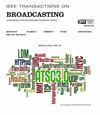LFIC-DRASC: Deep Light Field Image Compression Using Disentangled Representation and Asymmetrical Strip Convolution
IF 4.8
1区 计算机科学
Q2 ENGINEERING, ELECTRICAL & ELECTRONIC
引用次数: 0
Abstract
Light-Field (LF) image is emerging 4D data of light rays that is capable of realistically presenting spatial and angular information of 3D scene. However, the large data volume of LF images becomes the most challenging issue in real-time processing, transmission, and storage. In this paper, we propose an end-to-end deep LF Image Compression method Using Disentangled Representation and Asymmetrical Strip Convolution (LFIC-DRASC) to improve coding efficiency. Firstly, we formulate the LF image compression problem as learning a disentangled LF representation network and an image encoding-decoding network. Secondly, we propose two novel feature extractors that leverage the structural prior of LF data by integrating features across different dimensions. Meanwhile, disentangled LF representation network is proposed to enhance the LF feature disentangling and decoupling. Thirdly, we propose the LFIC-DRASC for LF image compression, where two Asymmetrical Strip Convolution (ASC) operators, i.e., horizontal and vertical, are proposed to capture long-range correlation in LF feature space. These two ASC operators can be combined with the square convolution to further decouple LF features, which enhances the model’s ability in representing intricate spatial relationships. Experimental results demonstrate that the proposed LFIC-DRASC achieves an average of 20.5% bit rate reductions compared with the state-of-the-art methods. Source code and pre-trained models of LFIC-DRASC are available atLFIC-DRASC:基于非纠缠表示和非对称条卷积的深光场图像压缩
光场图像是一种能够真实呈现三维场景空间和角度信息的新兴的光线四维数据。然而,LF图像的大数据量在实时处理、传输和存储方面成为最具挑战性的问题。为了提高编码效率,本文提出了一种基于非纠缠表示和非对称条卷积(LFIC-DRASC)的端到端深度LF图像压缩方法。首先,我们将LF图像压缩问题表述为学习一个解纠缠的LF表示网络和一个图像编解码网络。其次,我们提出了两种新的特征提取器,通过整合不同维度的特征来利用LF数据的结构先验。同时,提出解纠缠LF表示网络,增强LF特征的解纠缠和解耦性。第三,我们提出了LF图像压缩的LFIC-DRASC算法,其中提出了水平和垂直两个不对称条卷积算子(ASC)来捕获LF特征空间中的远程相关性。这两种ASC算子可以与平方卷积相结合,进一步解耦LF特征,增强了模型表示复杂空间关系的能力。实验结果表明,与目前最先进的方法相比,LFIC-DRASC平均降低了20.5%的比特率。LFIC-DRASC的源代码和预训练模型可在https://github.com/SYSU-Video/LFIC-DRASC上获得。
本文章由计算机程序翻译,如有差异,请以英文原文为准。
求助全文
约1分钟内获得全文
求助全文
来源期刊

IEEE Transactions on Broadcasting
工程技术-电信学
CiteScore
9.40
自引率
31.10%
发文量
79
审稿时长
6-12 weeks
期刊介绍:
The Society’s Field of Interest is “Devices, equipment, techniques and systems related to broadcast technology, including the production, distribution, transmission, and propagation aspects.” In addition to this formal FOI statement, which is used to provide guidance to the Publications Committee in the selection of content, the AdCom has further resolved that “broadcast systems includes all aspects of transmission, propagation, and reception.”
 求助内容:
求助内容: 应助结果提醒方式:
应助结果提醒方式:


